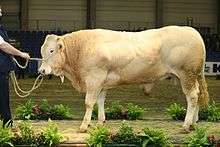Blonde d'Aquitaine
 Bull at Agriflanders in 2007 | |
| Conservation status | FAO (2007): not at risk[1]:143 |
|---|---|
| Country of origin | France |
| Distribution | worldwide |
| Use | meat |
| Traits | |
| Weight | Male: 1400 kg[2] |
| Female: 1050 kg[2] | |
| Height | Male: 165 cm[2] |
| Female: 155 cm[2] | |
| Skin color | white |
| Coat | wheaten |
| Horn status | horned in both sexes |
|
Cattle Bos (primigenius) taurus | |

The Blonde d'Aquitaine is a modern French breed of large domestic beef cattle. It was created in 1962 by merging three blonde draught breeds of south-western France, the Blonde des Pyrénées, the Blonde de Quercy and the Garonnaise.[3][4]:129 Since about 1970 it has been selectively bred specifically for beef production. It is the third-most numerous beef breed of France, after the Charolais and the Limousin. It has been exported to many countries round the world.
History
The Blonde d'Aquitaine breed was created in 1962 by merging three blonde breeds of south-western France, the Blonde de Quercy, the Garonnaise and the Blonde des Pyrénées.[3][4]:129 All three were principally draught breeds. The Garonnaise had been numerous in Aquitaine – 400 000 head were recorded in 1880; a herd-book was started in 1898. The Blonde des Pyrénées was itself an amalgam of several other breeds, including the Béarnaise, the Race d'Urt, and the Basquiaise;[5]:125[4]:207 its herd-book was started in 1920, the same year as that of the Blonde de Quercy.[4]:130
The Blonde d'Aquitaine includes almost all the traditional blonde cattle breeds of southern France, although remnant populations of a few of them have allowed them to be reconstituted. The moving force behind the creation of the breed was Raphaël Trémouille, a veterinary surgeon and member of the lower chamber of the French parliament.[4]:130 From about 1970, concerted efforts were made to improve the beef production attributes of the breed.[5]:132
The Blonde d'Aquitaine is the third beef breed of France by numbers, after the Charolais and the Limousin. In 2013 there were about 560 000 head in more than 18 000 farms.[5]:132 The Blonde d'Aquitaine has been exported to many countries of the world, including all countries of the European Union. It is much used for cross-breeding in Oceania and in Eastern Europe, and has shown particular promise when crossed with zebuine cattle breeds in South America.[4]:131
Characteristics
The Blonde d'Aquitaine is wheat- or cream-coloured, varying from a dark to very light fawn;[5]:132 the surround of the eyes and the area round the muzzle is paler.[4]:132 The skin is white, and the muzzle and mucous areas pale.[2]
Use
The Blonde d'Aquitaine is raised exclusively for beef, whether purebred or cross-bred. Bullocks reach almost 300 kg at 210 days, and about 500 kg at 15 months. Carcass yield is about 65%.[4]:132
References
- ↑ Barbara Rischkowsky, D. Pilling (eds.) (2007). List of breeds documented in the Global Databank for Animal Genetic Resources, annex to The State of the World’s Animal Genetic Resources for Food and Agriculture. Rome: Food and Agriculture Organization of the United Nations. ISBN 9789251057629. Accessed November 2016.
- 1 2 3 4 5 Étude de la race bovine: Blonde d'Aquitaine (in French). Bureau des Ressources Génétiques. Archived 9 March 2012.
- 1 2 Breed data sheet: Blonde d'Aquitaine/France. Domestic Animal Diversity Information System of the Food and Agriculture Organization of the United Nations. Accessed November 2016.
- 1 2 3 4 5 6 7 8 Marie Dervillé, Stéphane Patin, Laurent Avon (2009). Races bovines de France: origine, standard, sélection (in French). Paris: Éditions France Agricole. ISBN 9782855571515.
- 1 2 3 4 Valerie Porter, Lawrence Alderson, Stephen J.G. Hall, D. Phillip Sponenberg (2016). Mason's World Encyclopedia of Livestock Breeds and Breeding (sixth edition). Wallingford: CABI. ISBN 9781780647944.
![]() Media related to Blonde d'Aquitaine at Wikimedia Commons
Media related to Blonde d'Aquitaine at Wikimedia Commons